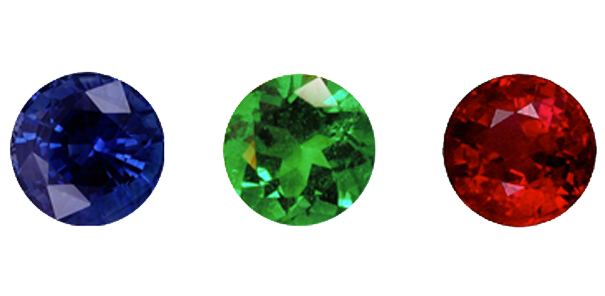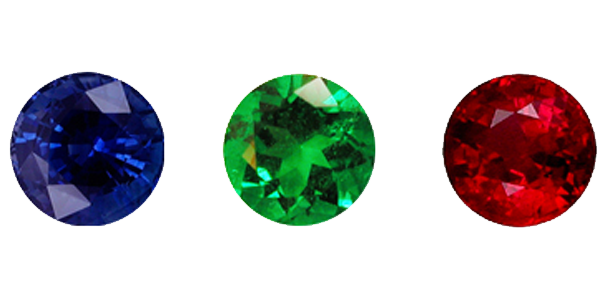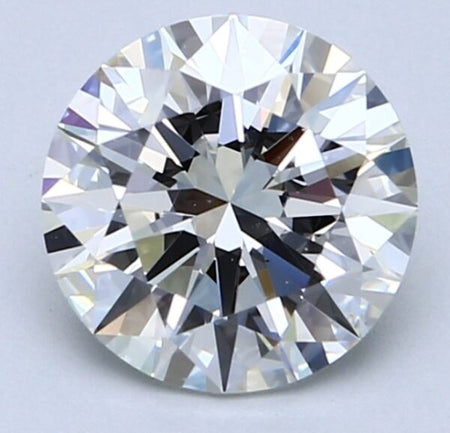manoj, company.com
CHOOSE A COLOUR G E M

CHOOSE A COLOUR
G E M

PROPERTIES:
When selecting a coloured stone certain properties of the gem should be understood. Some gems are much more durable to everyday wear then others. For example, sapphires and rubies with stand everyday wear, while opals and emerald should be worn on occasion. If a fragile stone is mounted in a ring it will endure much more wear than if it were mounted in a pendant. J. B. Simpson & Sons can recommend and design mountings that will protect fragile gems enabling increased wear.
SATURATION
What we look for in a fine or gem quality stone is consistency and fluency of colour. This does not imply a very dark or light colour, but a balanced fullness that has a slight transparency.
LUSTRE
This is a very important aspect of grading colour stones. Since coloured stones have different Reflective and refractive characteristics than that of a diamond, some light will travel within the gem and be lost through the pavilion (or belly) of the stone. It is the wave-length motion of colour glistening as if the colour was alive. The difference between very good lustre and poor lustre is obvious to the untrained eye.
CLARITY
Certain coloured stones characteristically have more inclusions or flaws than others. However, gems with minimal blemishes, or in some cases no inclusions at all, command the highest value.
CUT
Coloured gems are available in all shapes as well. Most stones can be facetted like a diamond, except gems like opal and turquoise. These gems are cut and polished into a cabochon shape (an oval or round polished dome shape).
The proportions of coloured stones are generally different from diamonds. The pavilion (or belly) of the gem usually has more depth and slightly different angles. This greater surface area allows for more facets, which, increase the internal reflection of light and overall lustre of the gem. The faceting of a gem must be symmetrical, sharp and clean to attain a very good cut grade.
Recent Articles
CHOOSING A DIAMOND
CHOOSING A DIAMOND J. B. Simpson Jewellers is committed to providing each client the finest diamond available for the best value. Purchasing a diamond is easier than many believe. The first step is to determine what amount you would like to spend. Diamonds can vary greatly in price relative to the quality desired. Today, you have the option of a Natural Diamond or a Lab Grown Diamond. See more information here: Natural vs Lab Grown Diamonds Explore the 4 ‘C’s’ of diamond quality below… BUY NATURAL DIAMONS BUY LAB GROWN DIAMONDS CHOOSE A SHAPE AND STYLE OF YOUR D I A M O N D CHOOSE THE C A R A T S I Z E CHOOSING THE C U T Q U A L I T Y The ideal shape for a diamond to attain the optimum light dispersion is the round brilliant cut. Quite simply put, the round shape is symmetrical, each facet is perfectly aligned. A Round Brilliant Cut Diamond has 58 facets, 33 on the crown (top) and 25 on the pavilion (bottom). IDEAL DIAMOND P R O P O R T I O N S The Grading Process to determine if a diamond is cut to its optimum brilliance can be classified as follows: CHOOSING THE C L A R I T Y Deciding what quality or clarity is relative to your budget and desire to own a diamond free of natural imperfections. Inclusions within a diamond act as obstacles to the light entering and dispersing from the stone. Large or plentiful inclusions block light refracting within the diamond and diminish the overall brilliance and scintillation. J. B. Simpson & Sons strongly recommend the clarity grade of VS2- SI 1 Clarity or better. Location of the inclusions are vital; a diamond with marks (preferable white or clear) that are near the outer edge will have the least impact on light travelling within the stone. The advantage to our client is a diamond with optimal brilliance, for a good value. The clarity of a diamond is graded using a microscope or eye loop at 10 power (10 times our eye as 20/20) by the amount and size of imperfections within the stone. These imperfections can be clear, white or black. FLAWLESS – is free of imperfections internally and on the surface. INTERNALLY FLAWLESS – free of internal imperfections, surface blemishes present. VVS – very, very slightly included- inclusions difficult to see @ 10 power. VS -very slightly included-inclusions difficult to see @ 10 power. SI – slightly included, inclusions visible @ 10 power, difficult to see with unaided eye. I – imperfect, inclusions visible to the untrained and unaided eye. CHOOSING THE C O L O U R Clear and colourless is a diamonds natural beauty. When choosing the colour of your diamond, the first question is, will the ring (mounting) be yellow gold, white gold or platinum? If the mounting is white, you want to choose a colourless diamond i.e.: D, E ,F, or G colour. If the mounting is yellow, you can choose a diamond with a slight tint of yellow, i.e.: H, I or J colour. A white ring will reflect near colourless light around the diamond, whereas a yellow ring will reflect tints of yellow around the diamond. As an example,. This simple fact will determine your investment in colour quality.
read MORENaturan vs Lab Grown Diamonds
Natural Diamonds Natural diamonds are formed by the heat and pressure of the Earth, from 1 to 3 billion years ago, making a natural diamond the oldest thing you will ever touch. The cost of mining, sorting, cutting, polishing and distribution of natural diamonds have a cost that exceeds that of man-made diamonds. Therefore, the residual value of a Natural diamond will always be greater. Natural diamond companies are committed to controlling and reducing their environmental impact, as well as protecting through conservation projects three times more land than they use. The natural diamond industry supports the livelihood of 10 million people globally. Together, the world’s leading diamond producers create $16 billion net positive socioeconomic and environmental benefits annually in countries where they operate–80% of which stays within local communities. Researchers are using the rocks in which diamonds are found called kimberlite to absorb carbon dioxide from the atmosphere, in a ground-breaking research program with the aim to reach carbon neutrality within this decade. The environmental impact of a one carat, polished natural diamond is about the same as the environmental impact in manufacturing 3 smartphones. Lab Grown Diamonds What is Lab-Grown Diamond? Lab-Grown Diamonds are optically, chemically, and physically, identical to natural diamonds and are created in a lab by scientists. Lab-grown diamonds provide the same luxurious diamond at flexible price points to fit anyone’s lifestyle. Lab-grown diamonds also offer the opportunity of a larger carat weight at lower costs. Lab-Grown Diamonds with GIA or IGI Reports have a Laser inscribed ID number that offers the ultimate safeguard. What Is the Difference Between Lab-Grown and Natural Diamonds? Optically: Indistinguishable from the naked eye, lab-grown diamonds present the same visible qualities as their natural counterparts. Chemically: Lab-grown diamonds are not simulants. They are formed from rough crystals taking an average of 2–4 weeks. Physically: To confidently tell lab-grown and natural diamonds apart, advanced instruments are needed to detect the physical aspects. How are Lab-Grown Diamonds Created? Lab-Grown Diamond manufacturers operate in highly controlled lab environments using one of two methods: High Pressure High Temperature (HPHT) or Chemical Vapor Deposition (CVD). Both processes begin with a diamond seed and result in a Lab-Grown Diamond. During the HPHT method, the scientist places the diamond seed in a growth chamber (apparatus), heats it to 2,700–3,100 degrees Fahrenheit, and exposes the seed to a pressure of 725,000 pounds per square inch, similar to the process that takes place in Earth’s mantle. The diamond seed remains under these intense conditions for varying lengths of time. The CVD method of Lab-Grown Diamond creation begins with flat diamond slabs placed in a reactor. The reactor is injected with Methane gas. The gas is exposed to microwaves which cause it to break down into its comprising atoms and generate a carbon-rich plasma cloud. The carbon atoms in the plasma connect with the diamond slabs and create new layers, resulting in slow vertical growth. Both the HPHT process and the CVD process produce Type IIa colorless Lab-Grown Diamonds, equal to some of the rare and sought-after types of Natural Diamond. These processes can also be adjusted to produce colored Lab-Grown Diamonds. Summary The residual value of a Lab Grown diamond is increasingly difficult to know in the future. The cost to produce each one has become stable enough in the last few years that the industry, in general, has been much more accepting of the market pricing. The original man-made diamonds produced by General Electric back in the 1950’s were about 10 times the cost to actually mine a rough diamond! Today, the cost is about 10 times less in some cases. We tell our clients that the cost is so much less for a man made diamond, it may be a more suitable purchase for our younger generations dreaming of a furnished house! One very important note is that we cannot guarantee that the value of a Lab Grown Diamond will be sustainable in the future. However, the cost to physically mine natural diamonds will continue to be more expensive because of input costs. Either way, we are happy to discuss the options available. For more information: https://www.naturaldiamonds.com/diamond-guide/natures-difference/
read MORECHOOSE A COLOUR G E M
CHOOSE A COLOUR G E M PROPERTIES:When selecting a coloured stone certain properties of the gem should be understood. Some gems are much more durable to everyday wear then others. For example, sapphires and rubies with stand everyday wear, while opals and emerald should be worn on occasion. If a fragile stone is mounted in a ring it will endure much more wear than if it were mounted in a pendant. J. B. Simpson & Sons can recommend and design mountings that will protect fragile gems enabling increased wear. SATURATIONWhat we look for in a fine or gem quality stone is consistency and fluency of colour. This does not imply a very dark or light colour, but a balanced fullness that has a slight transparency. LUSTREThis is a very important aspect of grading colour stones. Since coloured stones have different Reflective and refractive characteristics than that of a diamond, some light will travel within the gem and be lost through the pavilion (or belly) of the stone. It is the wave-length motion of colour glistening as if the colour was alive. The difference between very good lustre and poor lustre is obvious to the untrained eye. CLARITYCertain coloured stones characteristically have more inclusions or flaws than others. However, gems with minimal blemishes, or in some cases no inclusions at all, command the highest value. CUTColoured gems are available in all shapes as well. Most stones can be facetted like a diamond, except gems like opal and turquoise. These gems are cut and polished into a cabochon shape (an oval or round polished dome shape). The proportions of coloured stones are generally different from diamonds. The pavilion (or belly) of the gem usually has more depth and slightly different angles. This greater surface area allows for more facets, which, increase the internal reflection of light and overall lustre of the gem. The faceting of a gem must be symmetrical, sharp and clean to attain a very good cut grade.
read MORE


